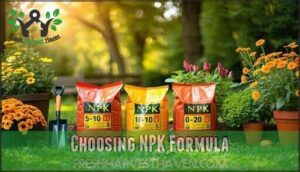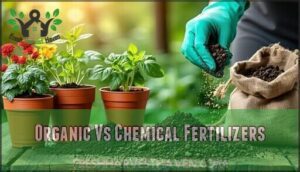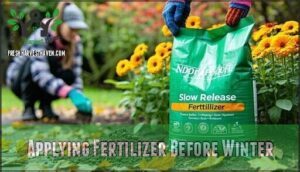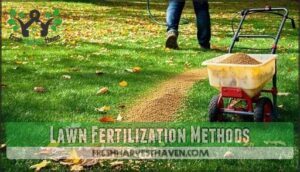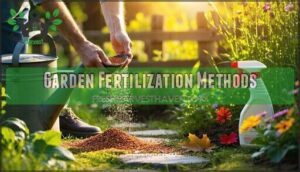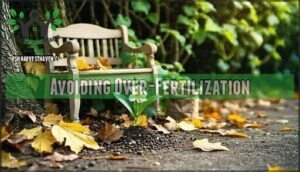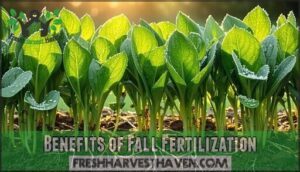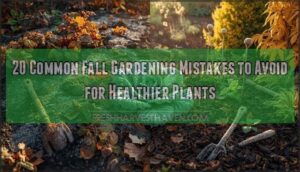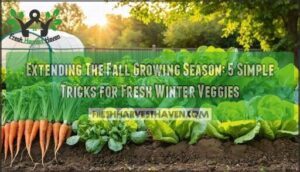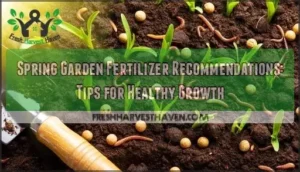This site is supported by our readers. We may earn a commission, at no cost to you, if you purchase through links.
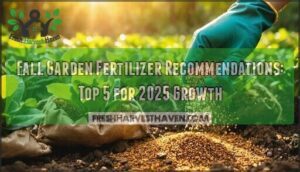
Apply fertilizers 6-8 weeks before your first hard frost, giving plants time to absorb nutrients before dormancy.
Choose fertilizers with higher potassium content to strengthen root systems and improve cold tolerance.
Organic options like compost, bone meal, and kelp provide slow-release nutrients while improving soil structure.
For lawns, winterizer fertilizers work best, while vegetable gardens benefit from balanced organic blends.
The key is feeding your plants what they need to survive winter and emerge stronger in spring, setting the stage for your most successful growing season yet.
Table Of Contents
- Key Takeaways
- Fall Fertilizer Timing
- Choosing NPK Formula
- Fall Garden Preparation
- Top 5 Fall Fertilizers
- Fertilizer Application Techniques
- Benefits of Fall Fertilization
- Frequently Asked Questions (FAQs)
- What is the best fertilizer to put on a garden in the fall?
- What is the best fertilizer number for fall?
- What is the best fertilizer to put down in October?
- What is the best time to put fall fertilizer down?
- What is the best fall lawn fertilizer?
- Should you choose a fall fertilizer for your lawn?
- What are the different types of fall lawn fertilizers?
- What fertilizer should I use for my Summer lawn?
- When should I apply fall fertilizer?
- Should you fertilize your plants in the fall?
- Conclusion
Key Takeaways
- Time your application carefully – You’ll get the best results by applying fertilizer 6-8 weeks before your first hard frost, giving plants time to absorb nutrients before dormancy sets in.
- Choose potassium-rich formulas for winter hardiness – You’ll want fertilizers with higher potassium content to strengthen root systems and improve your plants’ cold tolerance through harsh winter conditions.
- Pick the right NPK ratio for fall needs – You’ll need balanced formulas like 10-20-10 that emphasize phosphorus for root development while avoiding excessive nitrogen that can encourage vulnerable late-season growth.
- Consider organic options for long-term soil health – You’ll benefit from slow-release organic fertilizers like compost, bone meal, and kelp that improve soil structure while providing steady nutrition throughout winter.
Fall Fertilizer Timing
You’ll need to time your fall fertilizer application carefully based on your grass type and local climate conditions.
Apply fertilizer 4-6 weeks before your area’s first expected frost date to give nutrients time to absorb before the ground freezes.
Climate and Grass Type Considerations
Your grass types determine ideal fertilization strategies across different climate considerations.
Here’s your regional timing guide:
- Coolseason grasses in northern care zones need late-fall applications (September-October)
- Warmseason grasses in southern climates require early fall feeding (September only)
The timing can be influenced by several factors, including Microclimate impact, which affects timing by 2-4 weeks locally, and Grass variety, which influences nutrient needs and application windows.
Regional timing varies based on first frost dates and soil temperatures.
Fall fertilizer is essential for <strong>cool-season grass</strong> recovery from summer stress.
Average First Frost Dates
Knowing your average first frost dates helps you time fall garden fertilizer applications perfectly.
Historical averages from local weather stations provide reliable data sources for frost prediction, though regional variations mean neighboring areas can differ by weeks.
Microclimates impact your yard’s specific timing – low-lying areas freeze first while slopes stay warmer longer.
| Region | Average First Frost |
|---|---|
| Northern States | Mid-September to Early October |
| Central Plains | Late October to Early November |
| Southern States | Late November to December |
| Mountain Areas | Early September to Mid-October |
This fall garden care knowledge guarantees your fertilizing fall garden efforts maximize nutrient uptake before ground freezes, supporting healthy root development through winter months.
Fertilizing Before Rain
Once you’ve calculated your region’s first frost date, you’ll want to coordinate your fertilizer application with upcoming rainfall.
Timing your fall garden fertilizer around light rain creates perfect conditions for nutrient delivery while preventing costly runoff.
Light rain after fall fertilizing is nature’s way of delivering nutrients exactly where plants need them most.
Here’s your ideal timing strategy for fertilizing before rain:
- Apply fertilizer 1-2 days before predicted light rain
- Avoid heavy storms that cause nutrient washout
- Target gentle drizzles for maximum rainfall absorption
- Check weather forecasts for 3-day windows
- Skip application if frozen ground conditions exist
Rain intensity determines success—you want steady moisture that soaks nutrients into soil rather than heavy downpours that wash expensive fertilizer away.
This approach maximizes environmental impact benefits while ensuring your fall fertilizer tips actually reach plant roots where they’re needed most.
Choosing NPK Formula
You’ll need to understand NPK ratios to choose the right fertilizer for your fall garden’s specific needs.
Each number represents the percentage of nitrogen, phosphorus, and potassium that affects different aspects of plant health and growth.
Nitrogen for Leaf Growth
Fueling robust leaf development, nitrogen acts as your garden’s green engine during fall preparation.
This macronutrient strengthens grass blades against cold stress while extending lawn greenness through next summer.
Application timing matters—high-nitrogen formulations like 24-0-12 support cool-season grasses when applied early fall, preventing deficiency signs.
Nitrogen fertilizers are essential for winter preparation and spring recovery.
| Nitrogen Benefits | Application Details |
|---|---|
| Enhanced leaf color intensity | Apply 6 weeks before first frost |
| Increased growth rate potential | Use 20-8-8 ratios for cool-season grass |
| Cold stress resistance | Extends greenness through following summer |
| Photosynthesis optimization | Strengthens blades against winter damage |
| Nutrient storage boost | Supports spring regrowth preparation |
Phosphorus for Root Development
While phosphorus strengthens root mass development, it’s the unsung hero of winter hardiness preparation.
Phosphorus sources like superphosphate enhance root branching by 34%, improving water absorption during drought stress.
This essential fertilizer NPK ratio component promotes bloom promotion and deep root systems that access subsurface moisture.
Deficiency symptoms include stunted growth and poor flowering.
Your fall garden fertilizer should prioritize phosphorus for robust root development and ideal soil nutrients absorption.
Potassium for Cell Function
Potassium acts as your plant’s bodyguard against winter’s harsh conditions.
Potassium strengthens your garden’s winter armor, building frost resistance one cell at a time.
This essential nutrient strengthens cell walls and boosts frost resistance by increasing sugar concentrations in plant tissues. When you provide adequate potassium, you’re enhancing your garden’s ability to survive freezing temperatures.
- Cell Turgor: Maintains proper water pressure for structural integrity
- Enzyme Activation: Powers metabolic processes that store energy reserves
- Nutrient Transport: Moves essential minerals throughout plant systems efficiently
Fall Garden Preparation
You’ll need to decide between organic and chemical fertilizers before winter arrives, with each option offering distinct advantages for your garden’s health.
Organic fertilizers release nutrients slowly throughout winter and improve soil structure, while chemical options provide immediate nutrient availability but require careful timing to avoid plant damage from frost.
Organic Vs Chemical Fertilizers
When choosing between organic fertilizer and chemical fertilizers, you’ll find distinct trade-offs in nutrient release speed and environmental impact.
Organic fertilizers provide slow, steady nutrition over months while building soil health through microbial activity, though they’re costlier and require larger applications due to lower nutrient ratios.
Chemical fertilizers deliver immediate results with higher concentrations but can harm beneficial soil organisms and increase runoff risks, making application complexity simpler yet environmentally problematic for sustainable gardening practices.
Many gardeners find success using organic options for fall.
Applying Fertilizer Before Winter
Timing your fall garden fertilizer application correctly sets your plants up for winter success.
Apply your best fall fertilizer 6-8 weeks before the first expected hard frost to maximize nutrient storage and root strengthening.
- Choose slow-release formulas that provide steady nutrition without encouraging late-season growth
- Apply during dry conditions to prevent nutrient runoff and make certain proper soil absorption
- Focus on dormancy preparation by selecting fertilizers with lower nitrogen content for cold protection
Smart winterize garden fertilizer timing helps plants build winter hardiness naturally.
Adding organic matter helps improve soil structure effectively.
Top 5 Fall Fertilizers
You’ll need to select the right fertilizer for your specific lawn and garden needs this fall season.
These five top-rated options provide targeted nutrition to strengthen roots, improve cold tolerance, and prepare your plants for winter dormancy while setting the stage for vigorous spring growth.
1. Uncle Jim’s Red Wiggler Worms
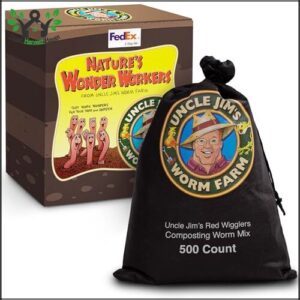
Uncle Jim’s Red Wiggler Worms represent nature’s most efficient organic fertilizer factory for your fall garden.
These composting champions transform kitchen scraps into premium vermicast benefits that’ll supercharge your soil health naturally.
Their nutrient-rich castings contain seven times more phosphates and five times more nitrogen than regular soil.
Your plants get sustained nutrition without chemical burns or runoff concerns.
| Feature | Benefit |
|---|---|
| Worm Reproduction | Self-sustaining population |
| Red Wiggler Care | Minimal maintenance required |
| Worm Habitat | Indoor/outdoor flexibility |
| Processing Speed | Faster decomposition |
| Soil Amendment | Long-term improvement |
Setting up worm composting couldn’t be simpler.
These hardy workers thrive in temperatures between 55-75°F, making them perfect for fall preparation.
You’ll harvest rich organic fall fertilizer within months while reducing household waste by 30%.
Fall is an ideal time for amendments as organic matter decomposes over the winter.
America’s largest worm farm guarantees quality breeding stock that’ll establish thriving colonies.
Your fall garden fertilizer becomes a year-round soil amendment system that keeps giving back.
2. Supercharge Plant Root Enhancer Concentrate
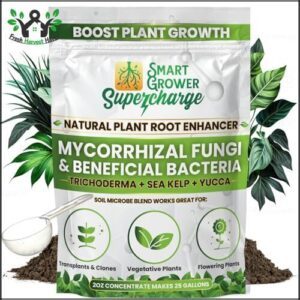
Root-boosting technology makes Supercharge Plant Root Enhancer Concentrate a game-changer for fall garden fertilizer applications. This powerful concentrate composition delivers 10% phosphorus and 12% potassium specifically designed for enhanced root development before winter dormancy sets in.
Supercharged roots build resilient gardens—nature’s foundation for thriving through winter’s challenges.
You’ll witness dramatic improvements in root mass within weeks, creating stronger, whiter root systems that’ll support vigorous spring growth. The soil compatibility extends across all growing media types, making application methods straightforward for any garden setup.
Simply mix 4-8 ml per gallon throughout growth cycles—no complicated measuring or guesswork required. This soil amendment works as both an organic fertilizer supplement and standalone root enhancer.
Available in 1- and 5-liter sizes, the product effectiveness delivers professional-grade results that home gardeners can trust. Plant roots respond quickly to this concentrated formula, establishing the foundation your garden needs for seasonal shifts.
Best For: Gardeners prioritizing robust root systems and long-term plant health through concentrated phosphorus-potassium nutrition.
3. Down to Earth Organic Kelp Fertilizer
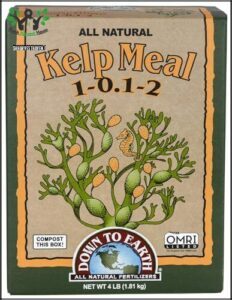
Down to Earth Organic Kelp Fertilizer brings the ocean’s bounty to your fall garden through sustainable harvesting practices that hand-collect Ascophyllum nodosum seaweed from pristine North Atlantic waters.
This organic fall fertilizer features a gentle 1-0.1-2 kelp nutrient profile that won’t burn sensitive plants during autumn shifts.
The application rate details are straightforward: spread 1⁄4 cup per square foot for new gardens or apply 1-2 teaspoons monthly around established plants.
Plant-specific uses include vegetables, herbs, flowers, and perennials that benefit from kelp’s natural growth hormones and trace minerals.
What sets this fall garden fertilizer apart are its soil enrichment benefits—it stimulates root development while providing essential potash that strengthens plants against winter stress.
The OMRI certification confirms this organic fertilizer meets strict standards for sustainable gardening practices, making it perfect for environmentally conscious gardeners preparing their plots for spring success.
4. Espoma Organic Fall Winterizer Lawn Food
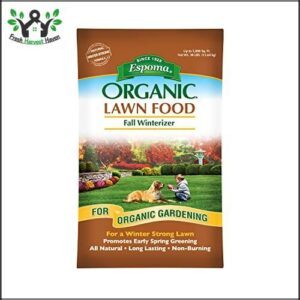
Organic Benefits shine through with Espoma Organic Fall Winterizer Lawn Food, delivering reliable Winter Protection without compromising safety.
This organic fall fertilizer features an 8-0-5 formula packed with potassium to help your lawn bounce back from summer stress while building cold-weather resilience.
You’ll love that this Espoma product contains zero synthetic chemicals or toxic sludges, making it completely safe around kids and pets.
The Slow Release formula provides Soil Enrichment that lasts months, delivering 2.5 times more sustained nitrogen than conventional options.
Apply this fall lawn fertilizer using any spreader from late summer through November at the recommended Application Rate.
Users consistently report remarkable spring green-up that’ll have neighbors wondering about your lawn care secrets.
Though pricier than synthetic alternatives, this American-made organic fertilizer proves its worth through long-lasting results and environmental responsibility—perfect for homeowners prioritizing both lawn health and family safety.
5. Scotts WinterGuard Fall Weed and Feed
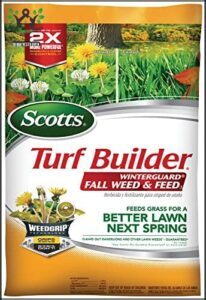
Scotts WinterGuard Fall Weed and Feed delivers a knockout punch to your lawn’s biggest problems.
This fall lawn fertilizer combines herbicide action with nutrient delivery, targeting over 50 weed species while building strong roots for winter survival.
The WinterGuard Benefits include eliminating clover, dandelions, and broadleaf weeds that compete with your grass for nutrients.
Application Specifics matter here—apply when temperatures hit 60°F-90°F on moist grass.
Skip watering for 24 hours after application to let the herbicide work effectively.
Each 11.43-pound bag provides Coverage Area for 4,000 square feet, making it cost-effective for larger lawns.
Consider the Environmental Impact when using this Weed and Feed product.
While effective, synthetic herbicides require careful application near water sources and sensitive plants.
This Scotts Turf Builder formula works best for homeowners prioritizing convenience and dual-action results in their fall fertilizer tips routine.
Fertilizer Application Techniques
Knowing the right fertilizer is only half the battle—applying it correctly guarantees your plants actually get the nutrients they need.
You’ll want to master different techniques for lawns versus gardens, plus learn when to stop before you accidentally harm your plants with too much of a good thing, which involves understanding complete concepts and applying them correctly to avoid damage.
Lawn Fertilization Methods
Proper lawn fertilization methods guarantee nutrients reach every grass blade effectively.
Your technique determines whether your fall lawn fertilizer delivers maximum results for healthy turf.
- Granular Application: Use broadcast spreaders with proper spreader calibration, maintaining steady walking speed for even distribution across large areas
- Liquid Fertilization: Apply with hose-end sprayers during cool mornings to prevent leaf burn and maximize nutrient absorption
- Spot Treatment: Target specific problem areas with concentrated applications, perfect for overseeding integration projects
Consider using a granular fertilizer spreader for even coverage.
Follow package rates—typically one pound nitrogen per 1,000 square feet for best fall lawn care results.
Garden Fertilization Methods
Unlike lawns requiring uniform coverage, your garden plants demand targeted fertilizer placement strategies. You’ll master garden fertilization methods using broadcasting for expansive beds, banding along plant rows, or precise soil incorporation around individual plants.
Granular vs liquid options offer different absorption rates—granular provides steady release while liquid delivers immediate nutrients through application tools like sprayers. Understanding the nuances of product selection matters for ideal results.
| Method | Best For | Timing |
|---|---|---|
| Broadcasting | Large garden beds | Early morning |
| Banding | Row crops | Before planting |
| Foliar feeding | Quick nutrient boost | Cool evenings |
Follow with proper watering practices to activate your fall garden fertilizer effectively.
Avoiding Over-Fertilization
Three primary signs warn you of overfertilization: yellowing leaves, stunted growth, and root burn along leaf edges.
Always follow your NPK formula guidelines precisely, as excess nutrients trigger nutrient toxicity and salt buildup in soil.
Growth imbalance occurs when you apply too much fertilizer, creating nutrient deficiencies elsewhere and harming beneficial microorganisms.
A soil test before fertilizer application prevents these issues and reduces water pollution from runoff.
Understanding phosphorus importance in root development can help prevent over-fertilization.
Benefits of Fall Fertilization
You’ll reap significant rewards when you fertilize your garden in fall, as this practice strengthens root systems and builds nutrient reserves that support vigorous spring growth.
Fall fertilization also enhances your plants’ cold tolerance and disease resistance, creating a protective foundation that helps them survive winter stress and emerge healthier when warm weather returns, which is crucial for vigorous spring growth and overall plant health, including improved disease resistance.
Promoting Healthy Plant Growth
When you apply fall garden fertilizer strategically, you’re investing in your garden’s long-term success and health.
Proper plant nutrition during autumn creates a foundation that transforms ordinary gardens into thriving ecosystems.
Consider these four transformative benefits:
- Enhanced Root Vigor – Roots expand deeper and stronger during cool weather
- Improved Winter Hardiness – Plants develop natural antifreeze compounds for cold protection
- Optimized Nutrient Uptake – Slow autumn growth maximizes fertilizer absorption efficiency
- Stronger Disease Resistance – Well-fed plants build robust immune systems against pathogens
Fall fertilizer recommendations focus on balanced plant growth rather than rapid development, ensuring your garden health improves steadily through dormancy.
Preparing Soil for Spring
Your soil preparation fall efforts create the foundation for vibrant spring growth. Strategic soil amendments and compost additions during autumn provide microorganisms months to break down organic matter, enriching your garden’s nutrient profile.
This fall compost application transforms into readily available spring nutrients when growing season arrives. To guarantee the best growth, remember to test soil pH and amend accordingly.
| Amendment Type | Application Timing | Spring Benefits |
|---|---|---|
| Compost Additions | 6-8 weeks before frost | Enhanced soil structure |
| Cover Cropping | Early fall planting | Natural nitrogen fixation |
| Fall Garden Fertilizer | After leaf drop | Stored spring nutrients |
| Garden Soil Amendment | Before ground freezes | Improved drainage |
The use of compost additions, cover cropping, and other amendments can significantly improve soil health and support natural nitrogen fixation and improved drainage. By following these steps and applying the right soil amendments at the correct time, you can ensure a healthy and thriving garden come spring.
Preventing Winter Damage and Disease
Once your soil’s set for spring, it’s time to focus on winter hardiness and disease resistance.
A smart fall garden fertilizer routine does more than feed plants—it shields them from cold and disease.
Here’s how you boost soil health and cold protection:
- Use slow-release nitrogen for snow mold prevention.
- Choose potassium-rich blends for hardening off.
- Remove diseased foliage for dormancy preparation.
- Avoid over-fertilizing to prevent winter damage.
Frequently Asked Questions (FAQs)
What is the best fertilizer to put on a garden in the fall?
Don’t put all your eggs in one basket—choose balanced fertilizers with high phosphorus content for fall gardens.
You’ll want NPK ratios like 10-20-10 or bone meal to promote strong root development.
What is the best fertilizer number for fall?
For fall fertilization, you’ll want fertilizer numbers around 10-20-10 or 12-24-12, which means double the phosphorus compared to nitrogen and potassium.
This ratio promotes strong root development while avoiding excessive leaf growth that winter weather can damage, which is crucial for the plant’s survival during harsh weather conditions, and supports healthy growth.
What is the best fertilizer to put down in October?
Looking at October fertilizer needs, you’ll want balanced NPK formulas like 10-20-10 that emphasize phosphorus for root development.
Cool-season grasses thrive with nitrogen-rich blends, while warm-season varieties need gentle, slow-release options before dormancy.
What is the best time to put fall fertilizer down?
Apply fall fertilizer 6-8 weeks before your area’s first expected frost. You’ll want to time it when grass growth slows but before the ground freezes completely.
What is the best fall lawn fertilizer?
Ironically, the "best" fertilizer won’t matter if your timing’s wrong.
You’ll want a slow-release formula with balanced NPK ratios like 10-10-10 or higher potassium content for winter hardiness and root development.
Should you choose a fall fertilizer for your lawn?
Yes, you should choose fall fertilizer for your lawn.
Cool-season grasses benefit from September-November feeding, while warm-season varieties need early fall nutrition to recover from summer stress and prepare for winter dormancy.
What are the different types of fall lawn fertilizers?
You’ll find three main fall lawn fertilizer types: granular slow-release formulas that feed grass gradually, liquid fertilizers for quick absorption, and organic options like compost that improve soil health naturally.
What fertilizer should I use for my Summer lawn?
Summer lawns need frequent nitrogen feeding to maintain that Instagram-worthy green color everyone craves.
Use a high-nitrogen fertilizer (like 30-0-4) every 6-8 weeks during active growth, watering immediately after application to prevent burning.
When should I apply fall fertilizer?
Apply fall fertilizer 4-6 weeks before your first expected frost date. You’ll want to time it when grass growth slows but before the ground freezes for ideal nutrient absorption.
Should you fertilize your plants in the fall?
Don’t put all your eggs in one basket – fall fertilization helps plants store energy for winter survival.
You should fertilize cool-season grasses in September-November and warm-season varieties in early fall to strengthen roots and improve cold tolerance.
Conclusion
Success with fall garden fertilizer recommendations transforms your garden into a powerhouse of resilience and growth.
You’ve learned that timing matters most—apply fertilizers 6-8 weeks before frost to maximize nutrient absorption.
Choose potassium-rich formulas for winter hardiness, whether you prefer organic compost or commercial winterizers.
By following these fall garden fertilizer recommendations, you’ll create the foundation for spectacular spring growth while protecting your plants through winter’s challenges.
- https://www.estabrooksonline.com/advice/article.asp?id=136
- https://agrilifeextension.tamu.edu/library/gardening/fertilizing/
- https://www.atlantaarbor.com/blog/trees-fertilization/
- https://mahoneysgarden.com/fall-fertilization-plant-tone-holly-tone-guide/
- https://gardenprofessors.com/what-about-fall-fertilization/

